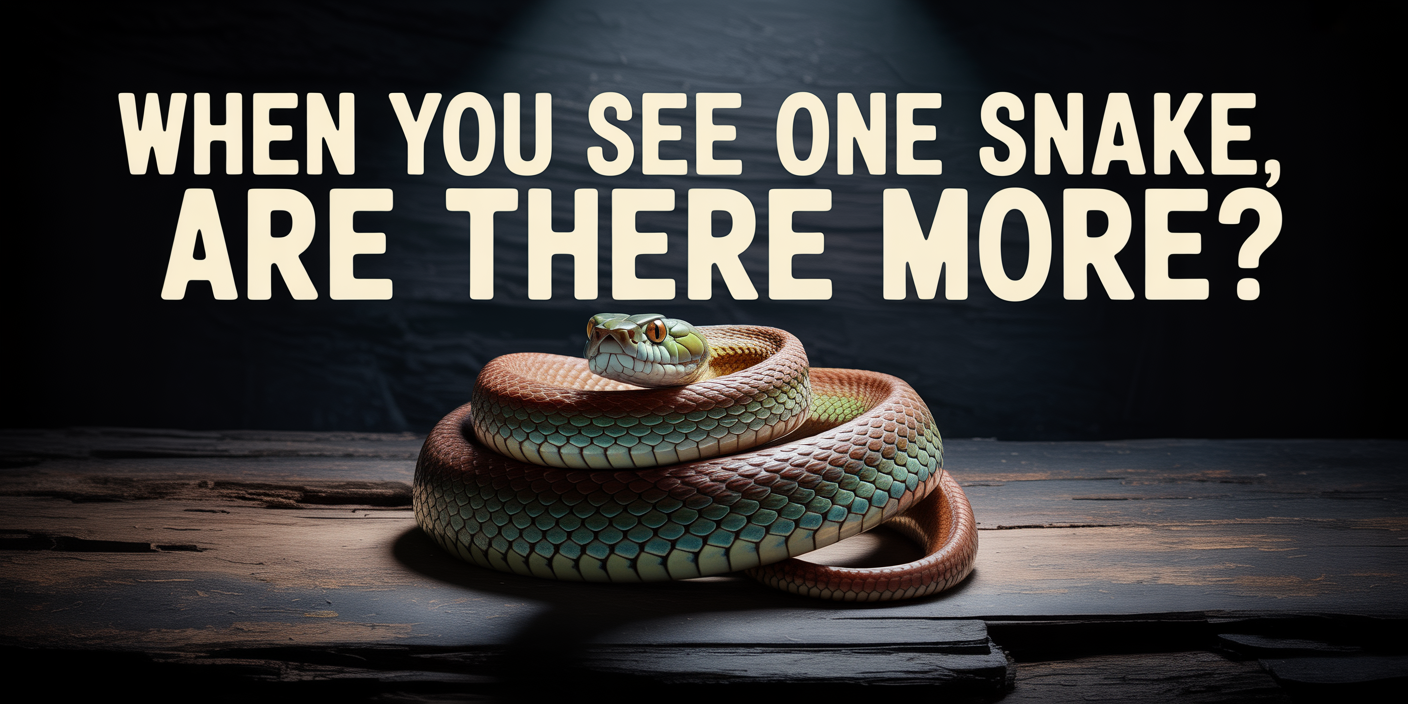Seeing one snake often means there are more nearby, as snakes are drawn to shared food sources and shelter spots. A single sighting usually signals hidden activity you might not notice right away.
Spotting a snake in your yard or home isn’t just an odd surprise; it’s a flashing warning sign. Most folks assume it’s a one-off thing, but in reality, snakes rarely operate completely solo. One snake often means conditions around your property are just right for more of them to stick around.
At AAAC Wildlife Removal, we’ve seen it play out time and again. A single sighting usually signals a deeper issue: hidden shelter spots, abundant food sources, or even a full-blown breeding situation. If you’re seeing even one, there’s a good chance it’s time to take a closer look before things escalate.
The Simple Truth: One Snake Rarely Means You’re Alone
If you’ve seen a snake slithering through your yard or garage, chances are it’s not the only one nearby. Snakes don’t always hunt or nest as a group, but they’re naturally drawn to the same resources such as food, water, and shelter. That means if your property offers those things, one snake’s appearance is often just the tip of the iceberg.
In areas like Dallas and surrounding suburbs where AAAC Wildlife Removal operates, we consistently find that one snake sighting usually connects to a larger presence. It could be a cluster hiding under your deck, nesting inside crawl spaces, or sharing the same hunting ground. The point is, seeing one should prompt you to assume there are more, not less.
Why Snakes Gather: The Top Triggers
Seeing one snake is rarely random. These reptiles follow specific needs and patterns, and understanding what draws them in helps explain why one sighting often signals more activity nearby.
1. Food Sources Are Abundant
Snakes don’t stick around for fun—they follow the food. If your yard has a rodent problem, bird nests, or heavy insect activity, you’re basically setting out a buffet. One snake might show up chasing prey, and others will follow once they catch the same scent trail.
In urban and suburban neighborhoods, properties with open trash bins, compost piles, or unsecured pet food tend to attract both pests and the predators that hunt them. The cycle keeps repeating until the food supply gets cut off or removed professionally.
2. Hidden Shelter Options
Snakes need quiet, undisturbed places to hide from predators and regulate their body temperature. That’s why spaces like under decks, sheds, woodpiles, and even crawl spaces become prime real estate. Once a snake finds a cozy hideout, others often follow suit, especially if the spot stays safe and cool year-round.
AAAC Wildlife Removal frequently uncovers multiple snakes nesting together in areas homeowners never think to check, behind stacked lumber, under patio furniture, or even inside storage boxes left outside.
3. Breeding Season Dynamics
During mating season, usually spring through early summer depending on your region, snakes become even more active. Males will roam larger areas searching for females, while females look for safe nesting spots. If you see a snake during this time, there’s a strong possibility it’s related to breeding behavior.
It’s not uncommon for us to find not just adult snakes, but also eggs or juveniles hidden nearby after a single adult sighting. That’s why timing matters, a lone snake today could mean a nest tomorrow.
4. Nearby Water Sources
Ponds, fountains, leaky hoses, or even shaded puddles can attract snakes looking to hydrate or cool down. Water sources also attract prey animals like frogs, insects, and small mammals, compounding the problem. If your yard has even a small water feature, spotting one snake likely means more are circling the same resource.
Spotting the Signs of a Bigger Problem
Catching sight of a single snake is often just the surface-level clue. There are plenty of subtle signs that indicate a larger snake presence around your home or property, many of which folks overlook until things get serious.
Keep an eye out for these indicators:
- Shed Snake Skins: Finding old snake skins around your yard, crawl space, or attic is a strong sign multiple snakes may be living nearby. Snakes shed regularly as they grow.
- Snake Droppings: These look similar to bird droppings but may contain traces of fur, bones, or scales from prey animals.
- Unusual Tracks or Drag Marks: Snakes leave winding, smooth trails through dust, dirt, or grass. If you notice these in consistent spots, you likely have more than one visitor.
- Odd Pet Behavior: Dogs or cats may act anxious or fixated on certain areas if they sense snake activity nearby. Pay attention if they repeatedly sniff or paw at specific spots.
- Rodent Activity Suddenly Drops: If you previously had a mouse problem that seems to have vanished, it might not be solved, it could mean snakes have taken over as the new predators.
At AAAC Wildlife Removal, spotting these secondary signs is part of how we assess a property thoroughly, not just looking for snakes but looking for the ecosystem signs they leave behind.
What NOT to Do When You Spot a Snake
It’s natural to want to handle things yourself, especially after spotting a snake in your yard or home. Still, acting on impulse usually does more harm than good, and can put you in danger.
Here are a few things to avoid when dealing with a snake sighting:
- Don’t Try to Catch or Kill It Yourself: Even non-venomous snakes can bite if provoked, and misidentifying a species could lead to serious risk.
- Don’t Block Off Entry Points Right Away: Sealing holes or gaps too soon can trap snakes inside your home, making removal harder.
- Don’t Use Harmful Chemicals or Repellents: DIY snake sprays and powders are often ineffective and can be dangerous to pets, kids, and local wildlife.
- Don’t Ignore It Hoping It’ll Leave: A snake that found food or shelter won’t just wander off. Ignoring the problem often leads to repeat sightings or a full infestation.
At AAAC Wildlife Removal, we always recommend a professional assessment before taking any action. It’s not just about removing the snake, it’s about addressing why it showed up in the first place.
Seeing One Snake Isn’t Random—It’s a Sign to Take Action
When you spot a single snake around your home or yard, it’s rarely just passing through. That sighting usually points to food sources, hidden shelter, or even breeding activity nearby, things that can attract more snakes if left unchecked.
Instead of waiting for the problem to grow, trust your instincts and take action early. Calling in professionals like AAAC Wildlife Removal ensures you’re not just removing one snake, but addressing the bigger picture before it turns into a real infestation.
Call AAAC Wildlife Removal for Expert Snake Control Today
If you’ve seen a snake around your property, don’t gamble on it being alone. One sighting often means there’s a hidden problem waiting to surface.
AAAC Wildlife Removal offers thorough inspections, safe removal, and long-term prevention strategies to keep your home snake-free. Call us today to schedule your professional snake control service—serving Dallas and surrounding areas with same-day response options available!




